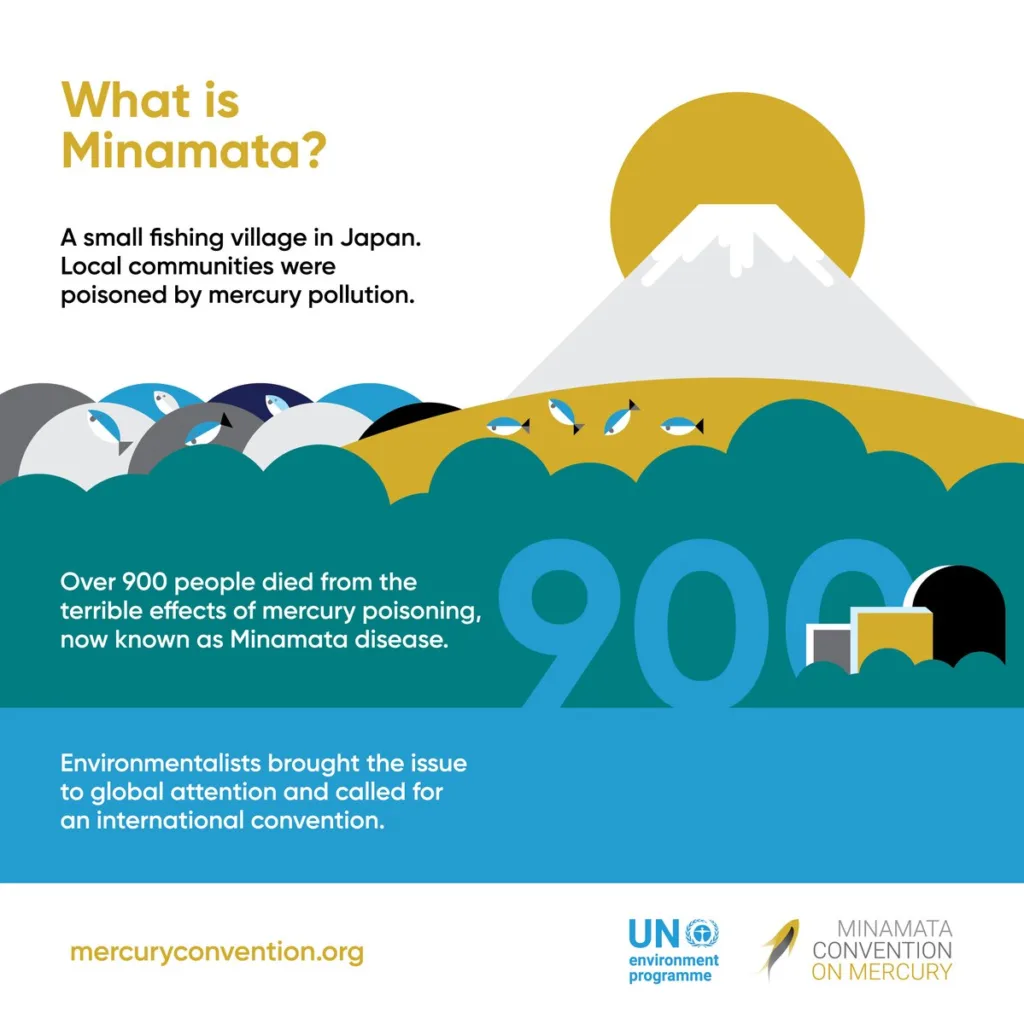
Minamata Convention on Mercury: Combating a Global Threat (Pic Credit: Minamata Convention )
Mercury, an element that exists naturally, is a hazardous heavy metal with substantial potential to harm both human well-being and the ecosystem if discharged into the atmosphere, water bodies, or soil. Its poisonous attributes are especially noticeable in its organic variant, known as methylmercury, which can amass within aquatic environments and then progress through the food web. The problem of mercury contamination has gained worldwide attention, resulting in the formulation of the Minamata Convention on Mercury. This international treaty aims to mitigate and regulate mercury emissions and releases, protecting human health and the environment from its adverse effects.
Table of Contents
Mercury Pollution: Sources and Impacts
Mercury contamination can stem from both natural occurrences like volcanic eruptions, as well as human actions. Activities linked to humans encompass gold mining, burning coal, making cement, incinerating waste, and industrial procedures like producing chlorine. These actions emit mercury into the atmosphere, which subsequently descends to the earth’s surface and infiltrates water sources. Within aquatic settings, mercury undergoes methylation, transforming into methylmercury. This methylmercury can amass in fish and shellfish, creatures that humans consume, ultimately resulting in mercury exposure.
The impacts of mercury pollution are extensive and severe. The impacts on health encompass neurological disorders, developmental shortcomings in children, compromised cognitive abilities, and harm to the cardiovascular system. Pregnant women and their developing fetuses are especially at risk because mercury can potentially breach the placental barrier. Moreover, ecosystems may experience disturbances in food chains, decreased biodiversity, and hindered reproductive success in aquatic organisms.

The Minamata Convention on Mercury
The Minamata Convention on Mercury, established in 2013, derives its name from the Japanese city where a significant mercury poisoning incident took place during the mid-20th century. This international agreement was created to tackle worldwide mercury pollution, primarily focusing on protecting human health and the environment from the detrimental impacts of mercury exposure. The convention’s key aims encompass managing mercury emissions stemming from industrial activities, reducing the utilization of mercury in various products and processes, and overseeing the artisanal and small-scale gold mining sector. This sector notably contributes to mercury pollution.

Key Provisions of the Minamata Convention
- Supply and Trade Control: The convention regulates the supply and trade of mercury, ensuring its production and use are conducted in a manner that reduces negative impacts. It aims to phase out the production, import, and export of mercury for certain uses.
- Artisanal and Small-Scale Gold Mining: The convention recognizes the importance of this sector for livelihoods but also its potential for releasing significant amounts of mercury. It encourages nations to develop strategies to reduce mercury use and promote safer alternatives to gold mining.
- Emissions and Releases: The convention sets out guidelines for controlling and reducing mercury emissions and releases from various sources, including industrial processes and waste incineration.
- Mercury-Added Products: The treaty addresses mercury-containing products like batteries, switches, and fluorescent lamps, promoting their phase-out and environmentally sound management.
- Contaminated Sites: The convention addresses the cleanup and remediation of mercury-contaminated sites, recognizing the long-lasting impacts of historical mercury pollution.
Progress and Challenges
Since its adoption, the Minamata Convention has made substantial progress in raising awareness about mercury pollution and promoting international cooperation to address the issue. Countries that have ratified the convention work towards meeting their obligations and targets, sharing experiences and best practices.
However, challenges remain. Effective implementation requires overcoming technical, financial, and institutional barriers. Developing countries may face difficulties in adopting safer alternatives to mercury use due to economic constraints. Monitoring and reporting mercury emissions and releases can also be complex, requiring reliable data collection and analysis systems.
India’s Role in Addressing Mercury Pollution
Being a participant in the Minamata Convention on Mercury, India holds a crucial position in the worldwide campaign against mercury pollution. The nation has implemented measures to control mercury discharges from various industries, encourage the safe utilization of products containing mercury, and investigate substitutes in areas such as healthcare and gold mining. By harmonizing its strategies with the convention’s goals, India adds to the joint effort of the global community to alleviate the detrimental impacts of mercury pollution on both human well-being and the ecosystem.
Conclusion
The ecosystem and human health are seriously threatened by the buildup of methylmercury in the food chain brought on by mercury contamination. The Minamata Convention on Mercury, established as a response, is a significant effort to tackle this issue. The convention provides a structure for regulating mercury emissions, advocating for safe alternatives, and protecting ecosystems. While challenges persist, international collaboration remains essential to effectively mitigate the impacts of mercury pollution and ensure a healthier and safer future for all.






